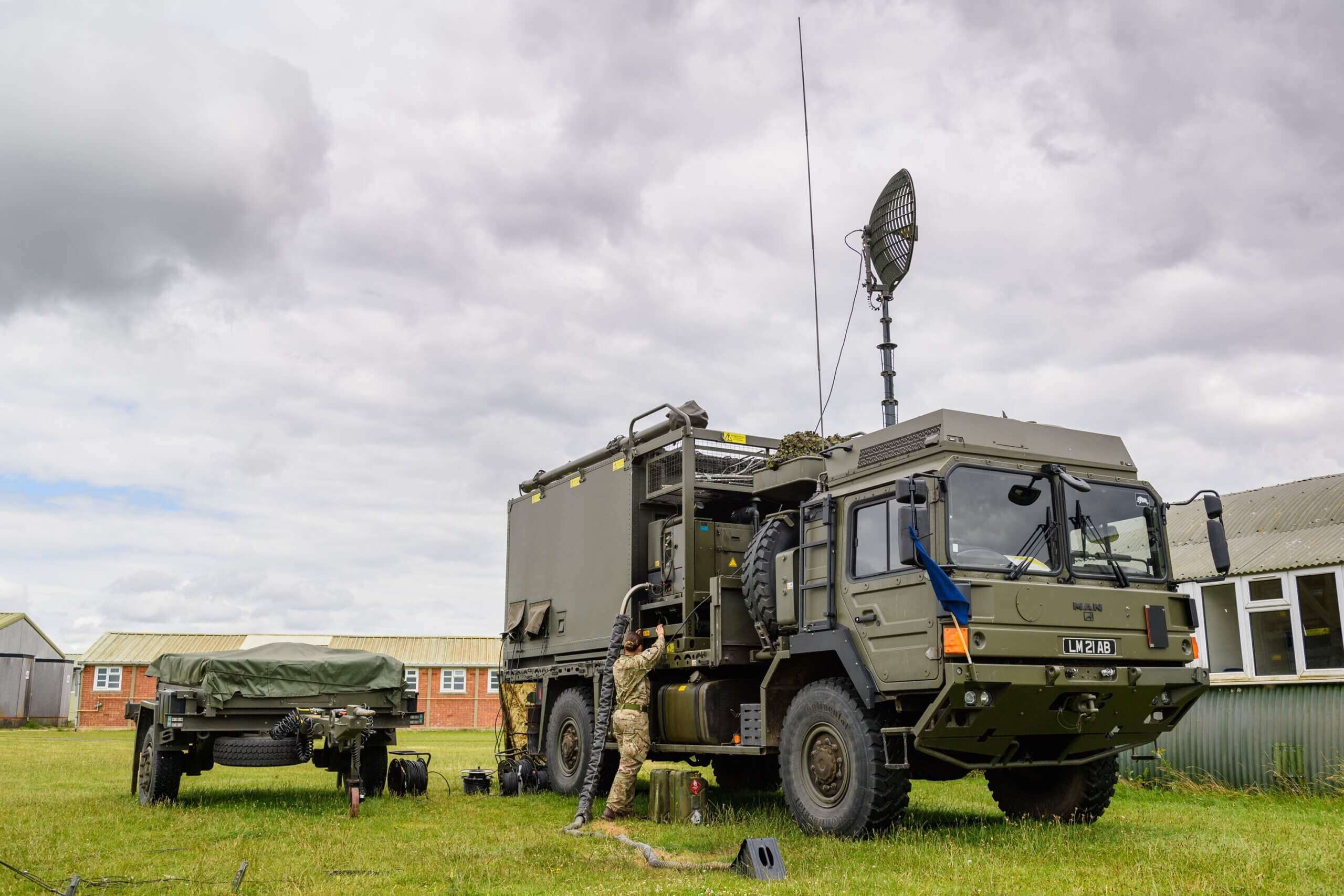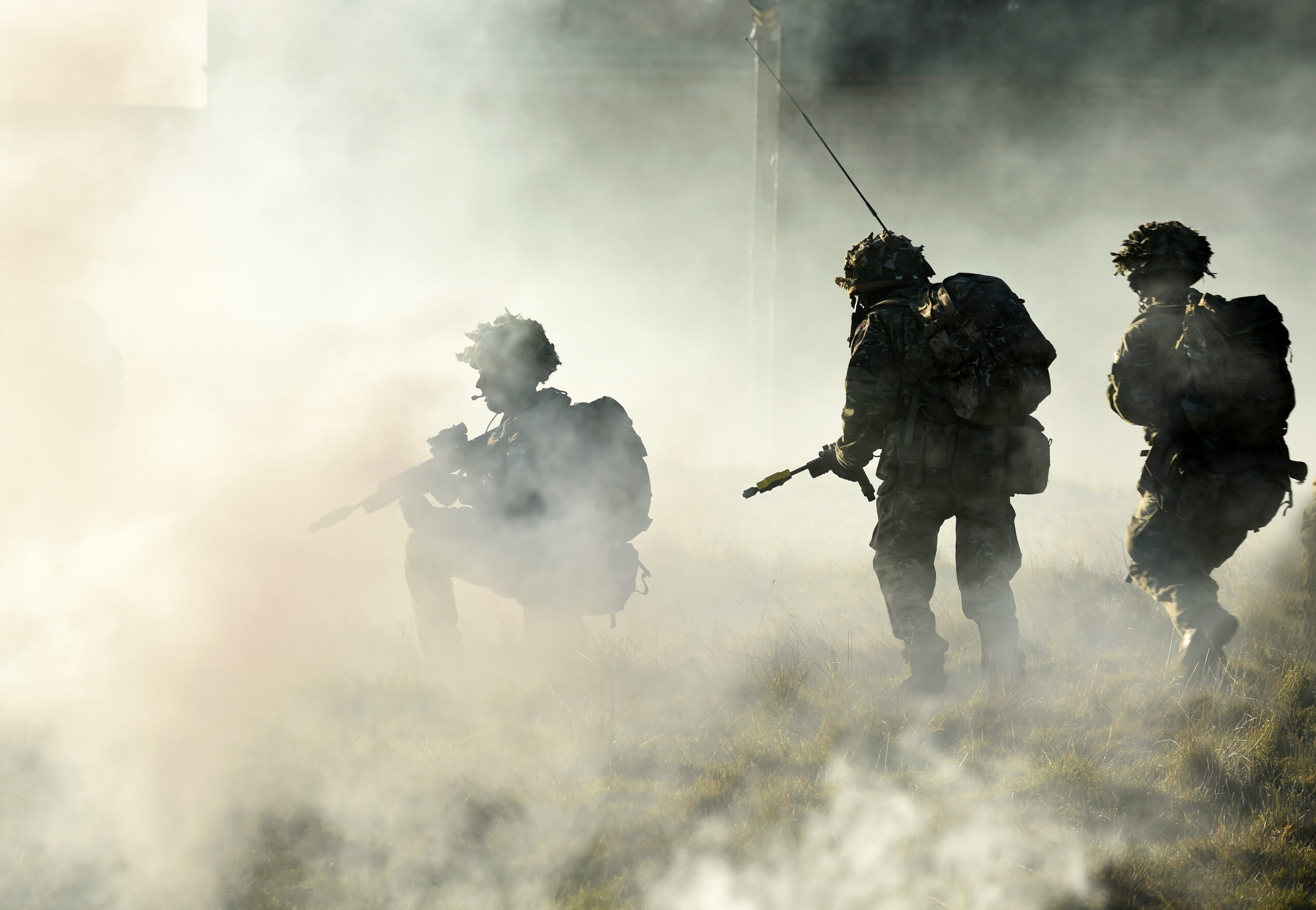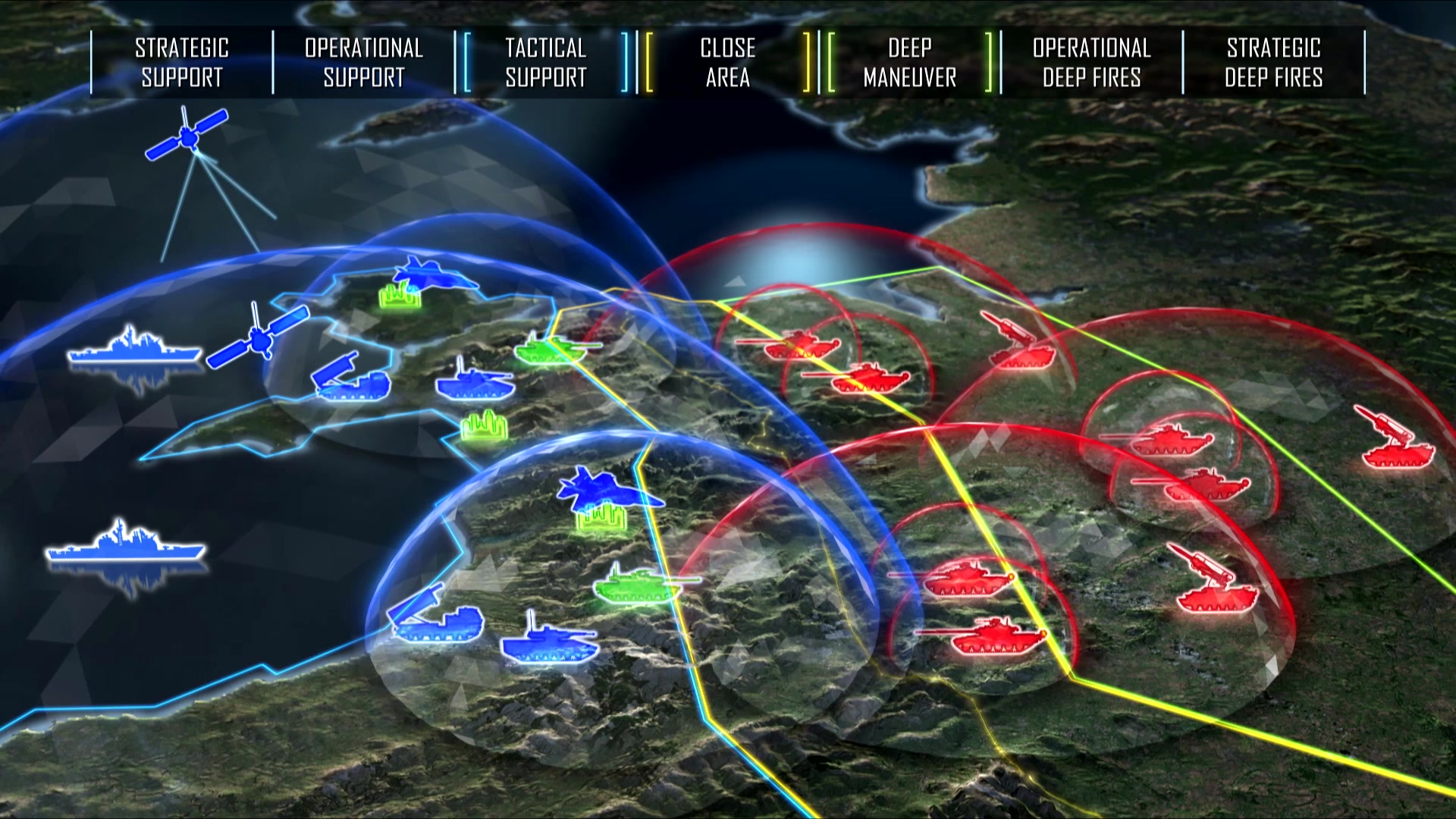In 2023, Project EVEREST demonstrated how UK land forces could improve their sharing of data between disparate systems. Plans are now underway for a new, bigger EVEREST experiment that aims to deepen resilient connectivity and compress the decision-action loop.
L3Harris Technologies conducted its first EVEREST experiment in 2023, a large demonstration of capability available today for the UK’s Ministry of Defence (MoD). EVEREST comprises a series of experiments designed to demonstrate the seamless and resilient networking of deployed sensors. The experiment took place on 14 and 15 June 2023 at the MoD’s BattleLab located in Dorset, southwest England. Preparations for EVEREST reportedly took only about three months, an impressive feat given the complexity of the endeavour.

Credit: L3Harris
Ensuring smooth information flows between deployed sensors is paramount. Militaries need to build rich common operating pictures to deepen their situational awareness, improve Command and Control (C2) and compress the decision-action or kill chain. There is every chance that the myriad of sensors an army may deploy on the battlefield all disseminate data using different protocols. For example, ground surveillance radars may output data in one specific language, deployed acoustic sensors in another. Different Signals Intelligence (SIGINT) sensors equipping disparate unmanned aerial vehicles (UAVs) may all use different formats for the data they gather and transmit. In our work and leisure time we can all experience frustration when these protocols do not work with each other. Someone may transfer a file, image, sound or video recording not recognised by the smartphone, tablet, laptop or desktop computer being used. Not only is this frustrating for troops, and personnel in general, it may impinge battle rhythm potentially risking success and costing lives.
The problem
Consider the effect that even a delay of minutes or seconds in sharing data could cause on the battlefield. Suppose a ground-based air surveillance radar has detected and identified a hostile unmanned aerial vehicle (UAV), the radar begins tracking this target and shares the accompanying track information using the ASTERIX (All-Purpose Structured Eurocontrol Surveillance Information Exchange) format; ASTERIX is employed extensively for the exchange of air traffic information. The radar might be able to send the ASTERIX data to a ground-based air defence (GBAD) battle management system with ease; it is likely that this system, given its role, will be configured to accept and interpret ASTERIX data. Yet what happens when the data does not translate easily, or is incompatible, with a different command and control system?
Perhaps a deployed electronic warfare (EW) jammer near the tactical edge is best placed to jam the GNSS (Global Navigation Satellite System) PNT (position, navigation and timing) signal the UAV relies on for navigation. The same EW unit may also be able to attack the radar the UAV is relying on to find its target. If the ASTERIX data is incompatible with the EW unit’s battle management system, it may be impossible to import the data. Worse still, incompatibility may cause the data to be uploaded, but corrupted. Corrupted data may mean that track data now shared with the EW unit is incomplete or totally incorrect. Errors like these could have potentially disastrous consequences. The hostile UAV may be left unscathed, or a different target, perhaps a friendly or neutral aircraft, may be targeted instead. One solution is for the UAV’s track data to be shared via written or voice communications. Written and voice communications take time and UAV track information may have expired by the time it reaches the EW unit, such is the rapid pace of the air battle. Voice communications risk being misheard or misinterpreted amidst the noise and stress of combat. Issues regarding data standardisation are therefore apparent, placing a premium on common protocols to avoid the aforementioned difficulties.
Project EVEREST was conceived by L3Harris to improve the ease with which data can be shared between different assets on and beyond the battlefield and to provide commanders at all levels a truly common operating picture. For this discussion, a military asset can include personnel, platforms, sensors, weapons systems, ordnance, bases, networks and accompanying capabilities. “We spent a long time examining the United Kingdom’s land warfare industrial strategy,” says Fred Hargreaves, the company’s director of strategy and engagement. The UK is currently pursuing several projects in the land warfare domain. For example, the British Army is acquiring new platforms including the GDELS Ajax and ARTEC Boxer armoured vehicles. Upgraded main battle tanks will be delivered in the form of the RBSL Challenger 3. Sky Sabre provides UK land forces with a short-medium range air defence, and Rafael provided Sky Sabre’s MIC4AD C2 system. MBDA furnishes the accompanying missiles and Saab the C-band (5.25-5.925 GHz) Giraffe Agile Multi-Beam radar.
To further complicate matters, new C2 and communications systems are on the horizon: BAE Systems is providing the British Army with a new wideband trunk communications system called Trinity to replace the existing Falcon trunk network. Project Morpheus, meanwhile, will supersede the UK’s Bowman tactical communications and C2 system. Morpheus provides a new combined communications, and command and control architecture. The project has been mired in controversy, although the existing Bowman capability will have to be replaced in the coming years since the current system is increasingly becoming unfit for purpose. A major motivation for L3Harris in devising Project EVEREST was the lack of “systems level connections” between these platforms and capabilities, according to Fred Hargreaves, Director Strategy and Engagement at L3Harris. A lack of such links could seriously hamper the abilities of these assets to share data efficiently between and beyond themselves.

Credit: Crown Copyright 2016
The 2023 EVEREST experiment included Exsel, Glenair, Inmarsat, L3Harris, Leonardo DRS, NSSLGlobal and Systematic with the aim of the experiment being to develop a network architecture that eases the exchange of data between military assets – chiefly troops, sensors and headquarters and to demonstrate to the MOD what is possible today. This supports the UK Chief of the General Staff’s aim to “double lethality in three years and treble it by the end of the decade”. It also supports the overwhelming desire to speed up UK procurement and place enhanced capability into the hands of the front-line user faster.
Lessons from Ukraine have also been taken into account, in particular showing how C2 can be performed from a distributed mobile headquarters, a key requirement to enhance the survivability of deployed forces. Easing the exchange of data is intended to enrich the British Army’s real-time common operating picture (COP). In turn, the COP should be designed to be made available to all land forces echelons, and also to allied forces. L3Harris officials previously told the author that the enriched COP provides blue force tracking, a recognised air picture and electronic warfare information. A key consideration in designing the EVEREST network architecture is that it can use existing British Army military communications links. These links include standard high frequency (HF: 3-30 MHz), very/ultra high frequency (V/UHF: 30 MHz to 3 GHz) and satellite communications (SATCOM) conduits.
The newer radios the British Army has procured enable interoperability with partner forces, but need to be fielded in greater numbers to have a real impact on the way the UK operates. The L3Harris officials noted that the data traffic will move across both dedicated military SATCOM links, as well as leased commercial SATCOM channels. The officials added that EVEREST has ensured that the network architecture is ‘future proofed’ in that it can migrate to future communications systems that the British Army will bring into service. Another key point is that the EVEREST architecture can be used by static, as well as physically and electronically manoeuvring forces. The theatre of operations in Ukraine has taught that speed is life; static targets are at a high risk of attack by artillery and air strikes.
Work performed by L3Harris and the associated EVEREST companies have designed the network architecture around a battlegroup-sized structure. Nonetheless, the L3Harris officials have shared in the past that the aspiration is for the EVEREST network architecture to be scalable according to mission requirements. Likewise, the architecture is intended to link outwards to maritime, air, space and cyber forces. It should similarly be able to receive and format incoming data from these latter sources.
Components
L3Harris revealed that it has supplied its tactical radios and datalinks, satellite communications (SATCOM) and intelligence, surveillance and reconnaissance (ISR) products to support EVEREST. All the systems used are available today and most are already in service in the UK in some form. The company’s CORVUS family of electronic warfare (EW) systems and its Drone Guardian counter-small UAV system were also employed. A key consideration in developing the EVEREST architecture was using hardware and software already available: “What off-the-shelf technology is available that UK land forces can use?” was a key guiding principle in enabling EVEREST, Hargreaves said. He noted that the key requirement was to use “open standards and open architectures, an approach that has eased the ability to share”.

Credit: Crown Copyright 2016
One UK MOD concern is the so-called Vendor Lock which occurs when a contractor builds a ‘closed’ capability which cannot easily be upgraded or modified without the vendor’s involvement. Users can find that the vendor thus has a monopoly on improving or upgrading a capability as it moves through its service life. For the UK MoD, this approach can be expensive as the ministry may have no-one else to turn to but the contractor vis-à-vis the upgrade. This reality may also mean that the contractor charges a premium for the work. Moreover, military assets must be able to slot into a data network with relative ease. Suddenly erupting conflicts may offer precious little time to plan and implement tactical networks. Having assets that plug into networks with ease is therefore seen as vital: “Standardising data protocols was a major part of EVEREST. You’ll always need to do some software tinkering, but keeping this to an absolute minimum is vital.”
Progress
L3Harris is dubbing last year’s effort EVEREST-1. Plans are afoot to take the work of EVEREST forward and to expand the initiative therein: “To date, the work we did with EVEREST-1 was focused on the battlegroup level,” according to Fred Hargreaves. Definitions differ, but in British Army terminology, a battlegroup is a tactical formation organised around an armoured regiment or infantry battalion. Assuming it goes ahead, EVEREST-2 will focus on brigade-level formations. L3Harris’ Hargreaves says that EVEREST-2 will include several elements. Lessons learned from EVEREST-1 could be applied to the existing Bowman, and forthcoming Trinity and Morpheus, networks. Another imperative will be overlaying resilience to cyber and electromagnetic effects across the British Army’s networks. It will also be necessary to develop the techniques and tactics regarding how UK land forces can fight with the EVEREST-2 architecture. There is likely to be a focus on how the architecture withstands and reconfigures in the face of intense hostile cyber-attacks and EW. A further consideration will be the acquisition strategies for the materiel and capabilities supporting the EVEREST-2 architecture. A key consideration of EVEREST-2 is how this capability supports data arriving from other sources such as the air and sea domains. Fred Hargreaves says that L3Harris is leaning heavily on the work it supports in these domains to address this connectivity.

Credit: US Army/Jason Norris
Lessons learned from EVEREST could have implications beyond the UK land forces since the UK MOD is moving forward with its adoption of NATO’s multi-domain operations (MDO) concept. NATO’s own literature says that “MDO refers to the push for NATO to orchestrate military activities across all operating domains and environments. These actions are synchronised with non-military activities and enable the Alliance to create desired outcomes at the right time and place.” The adoption of the MDO concept will let NATO “prepare, plan, orchestrate and execute coordinated activities in collaboration with other stakeholders and actors associated with the Alliance.”
In essence, NATO’s MDO concept sees a whole-of-membership approach to meeting strategic challenges. For example, an invasion of the Baltic states by Russia would not only involve the region’s national militaries as NATO militaries deployed to the area would be involved in repelling any Russian assault. Civilian governments, critical national infrastructure; industry and commerce; civil defence organisations and civil society, to name just some stakeholders, would all be involved in the contingency. The deep levels of data connectivity showcased by Project EVEREST play an important role in strengthening NATO’s wider MDO concept. The lessons learned today from EVEREST, and implemented across UK land forces, are likely to pay important dividends in future conflicts.
Thomas Withington



